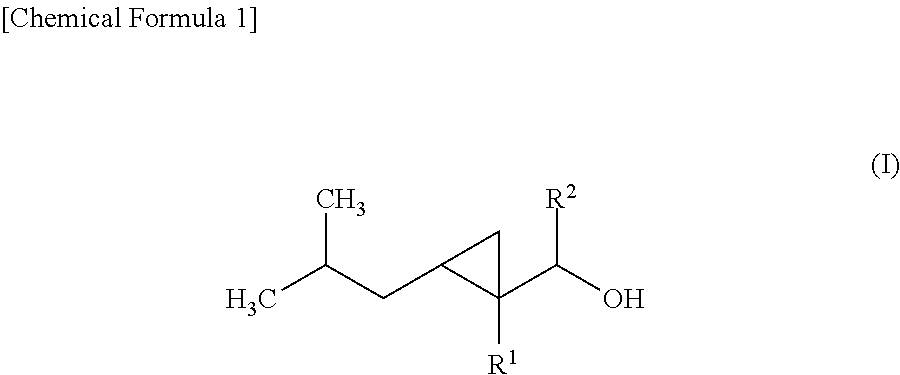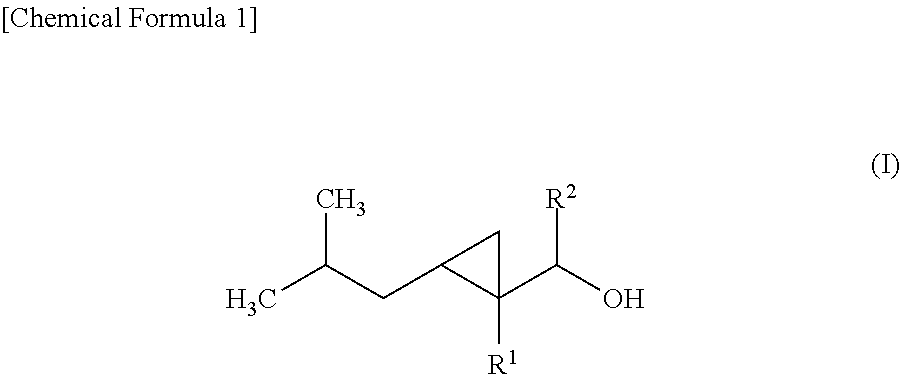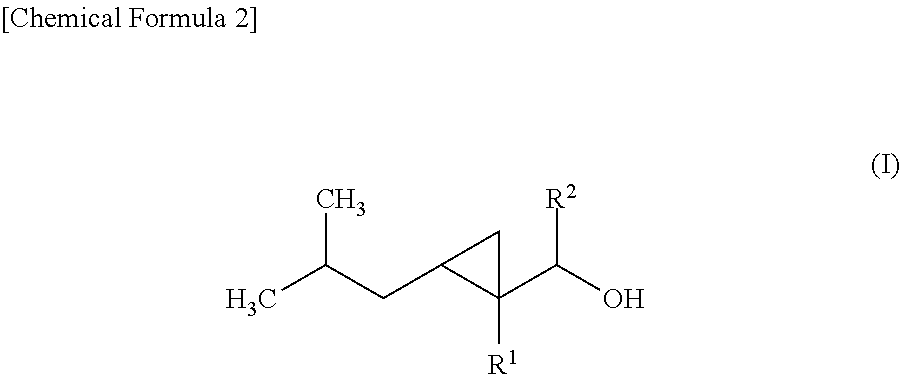Cyclopropane compound
a cyclopropane compound and fragrance technology, applied in the preparation of detergent mixture compositions, organic chemistry, hair cosmetics, etc., can solve the problems of difficult to predict the change of fragrance notes, difficult to predict the harmony with other fragrance ingredients, etc., and achieve excellent harmony and harmony excellent
- Summary
- Abstract
- Description
- Claims
- Application Information
AI Technical Summary
Benefits of technology
Problems solved by technology
Method used
Image
Examples
production example 1
Production of 3,6-dimethylhept-3-en-2-one (Compound (II-1)) and 7-methyloct-4-en-3-one (Compound (III-2))
[0103]
[0104]Sodium hydroxide (0.5 g), water (100 g), and 2-butanone (X) (210 g, 2.9 mol) were placed in a flask, which was maintained at 15° C. While the mixture was stirred, isovaleraldehyde (XI) (100 g, 1.2 mol) was added dropwise over five hours and then sodium hydroxide (1.0 g) was additionally added. This was further stirred at 25° C. for 48 hours. After stirring, the reaction solution was allowed to stand and then the lower layer was removed. Thereafter, excessive 2-butanone (X) was evaporated to dryness from the upper layer.
[0105]Subsequently, 85% phosphoric acid (5 g) was added to the upper layer portion of the reaction solution, and the flask was fitted with a water fractionator and heated to 120° C. to perform dehydration. Sodium hydroxide (3.5 g) was added to the reaction solution obtained after the dehydration to neutralize it and then it was dried. The resultant reac...
production example 2
Production of 3,6-dimethylheptene-2-ol (Compound (II-1))
[0108]
[0109]3,6-dimethylhept-3-en-2-one (Compound (III-1)) (6.1 g, 0.044 mol), cerium chloride heptahydrate (1.7 g, 0.044 mol), and methanol (45 mL) were added to a flask under a nitrogen atmosphere and cooled to 0° C. The mixture was further cooled to −8° C. and then sodium borohydride (1.7 g, 0.044 mol) was added in portions to the reaction mixture over 15 minutes. After stirring for two hours, the reaction solution was brought to 25° C. and an aqueous sulfuric acid solution was added thereto, which then was stirred for 20 minutes. Thereafter, an aqueous sodium hydroxide solution was added to the reaction mixture. After the pH of the reaction mixture was confirmed to be 6 to 7 using pH test paper, methanol was evaporated to dryness from the reaction mixture. Tert-butyl methyl ether and saturated brine were added to and mixed with the reaction mixture and then the aqueous layer and the organic layer were separated from each ot...
example 1
Production of 1-(2-isobutyl-1-methylcyclopropyl)ethan-1-ol (Compound I-1))
[0110]
[0111]3,6-Dimethylheptene-2-ol (Compound (II-1)) (3.2 g, 0.22 mol) and dichloromethane (45 mL) were added to a flask and cooled to −10° C. A solution of diethylzinc in hexane (1.09 mol / L, 50 mL, 0.055 mol, 0.25 times by mole with respect to Compound (II-1)) was added to the reaction mixture, which then was stirred for 30 minutes. Thereafter, diiodomethane (14.6 g, 0.055 mol) was slowly added dropwise using a dropping funnel. After completion of the dropwise addition, the reaction solution was brought to 25° C. and stirred for two hours. After 20 mL of saturated aqueous ammonium chloride solution was added to the reaction mixture, 30 mL of diethyl ether and 35 mL of aqueous 2N hydrochloric acid solution were added thereto, which then was stirred until the aqueous layer and the organic layer became transparent. After the organic layer and the aqueous layer were separated from each other, water was added to...
PUM
| Property | Measurement | Unit |
|---|---|---|
| temperature | aaaaa | aaaaa |
| temperature | aaaaa | aaaaa |
| length | aaaaa | aaaaa |
Abstract
Description
Claims
Application Information
 Login to View More
Login to View More - R&D
- Intellectual Property
- Life Sciences
- Materials
- Tech Scout
- Unparalleled Data Quality
- Higher Quality Content
- 60% Fewer Hallucinations
Browse by: Latest US Patents, China's latest patents, Technical Efficacy Thesaurus, Application Domain, Technology Topic, Popular Technical Reports.
© 2025 PatSnap. All rights reserved.Legal|Privacy policy|Modern Slavery Act Transparency Statement|Sitemap|About US| Contact US: help@patsnap.com



